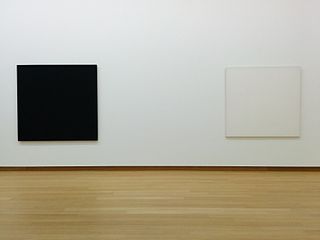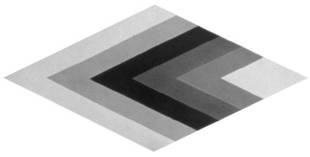
Abstract art uses visual language of shape, form, color and line to create a composition which may exist with a degree of independence from visual references in the world.

Postmodern art is a body of art movements that sought to contradict some aspects of modernism or some aspects that emerged or developed in its aftermath. In general, movements such as intermedia, installation art, conceptual art and multimedia, particularly involving video are described as postmodern.
An art movement is a tendency or style in art with a specific common philosophy or goal, followed by a group of artists during a specific period of time, or, at least, with the heyday of the movement defined within a number of years. Art movements were especially important in modern art, when each consecutive movement was considered as a new avant-garde movement. Western art had been, from the Renaissance up to the middle of the 19th century, underpinned by the logic of perspective and an attempt to reproduce an illusion of visible reality. By the end of the 19th century many artists felt a need to create a new style which would encompass the fundamental changes taking place in technology, science and philosophy.
Postminimalism is an art term coined by Robert Pincus-Witten in 1971 and used in various artistic fields for work which is influenced by, or attempts to develop and go beyond, the aesthetic of minimalism. The expression is used specifically in relation to music and the visual arts, but can refer to any field using minimalism as a critical reference point. In music, "postminimalism" refers to music following minimal music.
This is a chronological list of periods in Western art history. An art period is a phase in the development of the work of an artist, groups of artists or art movement.

Bob Law was a founding father of British Minimalism concerning painting and sculpture. A prolific artist throughout his lifetime, Law struggled with ideas surrounding the legitimacy and significance of abstract art.

The Modern Art Museum of Fort Worth is an art museum of post-World War II art in Fort Worth, Texas with a collection of international modern and contemporary art. Founded in 1892, The Modern is located in the city's cultural district in a building designed by architect Tadao Ando which opened to the public in 2002. The museum is accredited by the American Alliance of Museums and holds a permanent collection with more than 3,000 works of art.

Lyrical abstraction is either of two related but distinct trends in Post-war Modernist painting:
The Park Place Gallery was a contemporary cooperative art gallery, in operation from 1963 to 1967, and was located in New York City. The Park Place Gallery was a notable as a post-World War II gallery for both its location and that it supported a group of artists working with geometric abstraction and space.
Twentieth-century art—and what it became as modern art—began with modernism in the late nineteenth century.

The history of Western painting represents a continuous, though disrupted, tradition from antiquity until the present time. Until the mid-19th century it was primarily concerned with representational and Classical modes of production, after which time more modern, abstract and conceptual forms gained favor.
In the visual arts, late modernism encompasses the overall production of most recent art made between the aftermath of World War II and the early years of the 21st century. The terminology often points to similarities between late modernism and post-modernism although there are differences. The predominant term for art produced since the 1950s is contemporary art. Not all art labelled as contemporary art is modernist or post-modern, and the broader term encompasses both artists who continue to work in modern and late modernist traditions, as well as artists who reject modernism for post-modernism or other reasons. Arthur Danto argues explicitly in After the End of Art that contemporaneity was the broader term, and that postmodern objects represent a subsector of the contemporary movement which replaced modernity and modernism, while other notable critics: Hilton Kramer, Robert C. Morgan, Kirk Varnedoe, Jean-François Lyotard and others have argued that postmodern objects are at best relative to modernist works.

Systems art is art influenced by cybernetics, and systems theory, that reflects on natural systems, social systems and social signs of the art world itself.
Craig Kauffman was an artist who has exhibited since 1951. Kauffman's primarily abstract paintings and wall relief sculptures are included in over 20 museum collections, including the Museum of Modern Art, the Whitney Museum of American Art, the Tate Modern, the Louisiana Museum of Modern Art, the Art Institute of Chicago, the Los Angeles County Museum of Art, Seattle Art Museum, and the Museum of Contemporary Art, Los Angeles.
Neo-minimalism is an amorphous art movement of the late 20th and early 21st centuries. It has alternatively been called Neo-Geometric or "Neo-Geo" art. Other terms include: Neo-Conceptualism, Neo-Futurism, Neo-Op, Neo-pop, New Abstraction, Poptometry, Post-Abstractionism, and Smart Art.
Post-painterly abstraction is a term created by art critic Clement Greenberg as the title for an exhibit he curated for the Los Angeles County Museum of Art in 1964, which subsequently travelled to the Walker Art Center and the Art Gallery of Toronto.

Minimalism describes movements in various forms of art and design, especially visual art and music, where the work is set out to expose the essence, essentials or identity of a subject through eliminating all non-essential forms, features or concepts. As a specific movement in the arts it is identified with developments in post–World War II Western Art, most strongly with American visual arts in the 1960s and early 1970s. Prominent artists associated with this movement include Ad Reinhardt, Nassos Daphnis, Tony Smith, Donald Judd, John McCracken, Agnes Martin, Dan Flavin, Robert Morris, Larry Bell, Anne Truitt, Yves Klein and Frank Stella. Artists themselves have sometimes reacted against the label due to the negative implication of the work being simplistic. Minimalism is often interpreted as a reaction to abstract expressionism and a bridge to postminimal art practices.

Modern sculpture is generally considered to have begun with the work of Auguste Rodin, who is seen as the progenitor of modern sculpture. While Rodin did not set out to rebel against the past, he created a new way of building his works. He "dissolved the hard outline of contemporary Neo-Greek academicism, and thereby created a vital synthesis of opacity and transparency, volume and void". Along with a few other artists in the late 19th century who experimented with new artistic visions in sculpture like Edgar Degas and Paul Gauguin, Rodin invented a radical new approach in the creation of sculpture. Modern sculpture, along with all modern art, "arose as part of Western society's attempt to come to terms with the urban, industrial and secular society that emerged during the nineteenth century".

Rosemarie Castoro was an American artist associated with the New York Minimalists. She worked in drawing, painting, sculpture, and other media. She was associated with Minimalism, Conceptual art, and concrete poetry. Castoro was a practitioner of monochrome painting and abstraction. Movement of the human body through physical space was a recurring theme in her work.